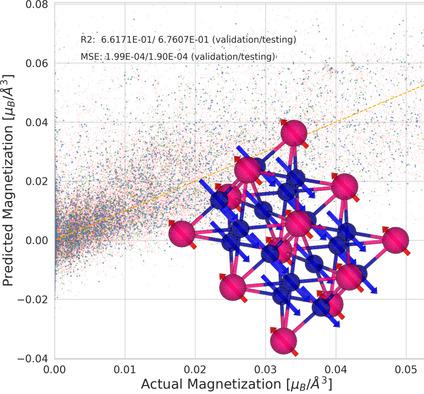当前位置:
X-MOL 学术
›
Phys. Status Solidi B
›
论文详情
Our official English website, www.x-mol.net, welcomes your
feedback! (Note: you will need to create a separate account there.)
Machine Learning in Magnetic Materials
Physica Status Solidi (B) - Basic Solid State Physics ( IF 1.5 ) Pub Date : 2021-05-04 , DOI: 10.1002/pssb.202000600 Georgios Katsikas 1 , Charalampos Sarafidis 1 , Joseph Kioseoglou 1
Physica Status Solidi (B) - Basic Solid State Physics ( IF 1.5 ) Pub Date : 2021-05-04 , DOI: 10.1002/pssb.202000600 Georgios Katsikas 1 , Charalampos Sarafidis 1 , Joseph Kioseoglou 1
Affiliation

|
The technological advancements of every era of human civilization owe themselves to the materials available at the time. Despite the substantial interest in the discovery of novel materials, materials research remains a very delicate and time-exhaustive procedure. Over the last 30 years, ab initio computational methods based on density functional theory (DFT) have allowed researchers to explore materials with ease and expect above-experiment measurement precision. However, DFT-based detailed investigation of novel materials is generally computationally intensive and greatly time-consuming. This review presents machine learning methods applied to DFT simulation data to uncover connections between material structure, chemical composition, and magnetization, a target property chosen for its great industrial demand. Models are developed that can partially circumvent the need for simulation, guiding researchers in the design of magnetic materials. Specifically, the Materials Project database is examined and it is concluded that Eu, Gd, Pu, Fe, Np, Mn, U, Cr, Co, and Ce are amongst the most common elements found in magnetic materials, and that materials of the same composition may have different magnetization depending on their space group. A neural network capable of predicting magnetization with a standard error of 8.3 × 10−3
μ
B Å−3 is created.
中文翻译:

磁性材料中的机器学习
人类文明每个时代的技术进步都归功于当时可用的材料。尽管人们对发现新材料非常感兴趣,但材料研究仍然是一个非常微妙且耗时的过程。在过去的 30 年中,基于密度泛函理论 (DFT) 的从头计算方法使研究人员能够轻松探索材料,并期望获得高于实验的测量精度。然而,基于 DFT 的新材料详细研究通常计算量大且耗时。本综述介绍了应用于 DFT 模拟数据的机器学习方法,以揭示材料结构、化学成分和磁化强度之间的联系,磁化强度是为其巨大的工业需求而选择的目标特性。开发的模型可以部分规避模拟的需要,指导研究人员设计磁性材料。具体而言,对材料项目数据库进行了检查,得出的结论是 Eu、Gd、Pu、Fe、Np、Mn、U、Cr、Co 和 Ce 是磁性材料中最常见的元素,并且具有相同组成可能具有不同的磁化强度,这取决于它们的空间群。一个能够以 8.3 × 10 的标准误差预测磁化强度的神经网络 并且相同成分的材料可能具有不同的磁化强度,这取决于它们的空间群。一个能够以 8.3 × 10 的标准误差预测磁化强度的神经网络 并且相同成分的材料可能具有不同的磁化强度,这取决于它们的空间群。一个能够以 8.3 × 10 的标准误差预测磁化强度的神经网络-3 μ B Å -3被创建。
更新日期:2021-05-04
中文翻译:

磁性材料中的机器学习
人类文明每个时代的技术进步都归功于当时可用的材料。尽管人们对发现新材料非常感兴趣,但材料研究仍然是一个非常微妙且耗时的过程。在过去的 30 年中,基于密度泛函理论 (DFT) 的从头计算方法使研究人员能够轻松探索材料,并期望获得高于实验的测量精度。然而,基于 DFT 的新材料详细研究通常计算量大且耗时。本综述介绍了应用于 DFT 模拟数据的机器学习方法,以揭示材料结构、化学成分和磁化强度之间的联系,磁化强度是为其巨大的工业需求而选择的目标特性。开发的模型可以部分规避模拟的需要,指导研究人员设计磁性材料。具体而言,对材料项目数据库进行了检查,得出的结论是 Eu、Gd、Pu、Fe、Np、Mn、U、Cr、Co 和 Ce 是磁性材料中最常见的元素,并且具有相同组成可能具有不同的磁化强度,这取决于它们的空间群。一个能够以 8.3 × 10 的标准误差预测磁化强度的神经网络 并且相同成分的材料可能具有不同的磁化强度,这取决于它们的空间群。一个能够以 8.3 × 10 的标准误差预测磁化强度的神经网络 并且相同成分的材料可能具有不同的磁化强度,这取决于它们的空间群。一个能够以 8.3 × 10 的标准误差预测磁化强度的神经网络-3 μ B Å -3被创建。











































 京公网安备 11010802027423号
京公网安备 11010802027423号